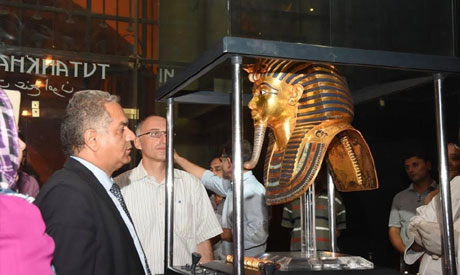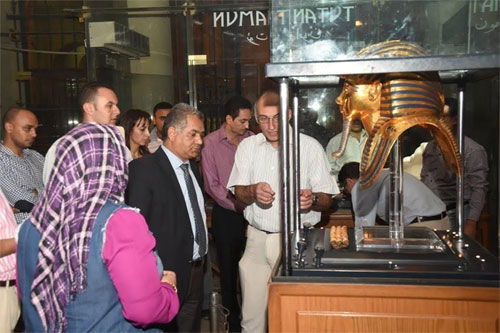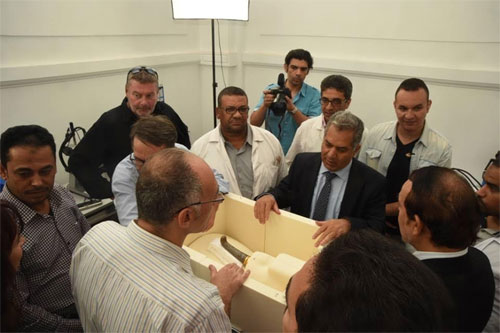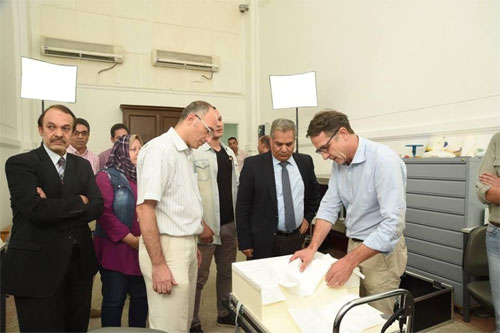http://english.ahram.org.eg/NewsContent/9/40/152682/Heritage/Ancient-Egypt/Tutankhamuns-mask-leaves-display-for-restoration-a.aspx
Tutankhamun's mask leaves display for restoration at Egyptian museum
The golden mask is guaranteed a ‘safe transportation and restoration process’ by a team who have ‘left nothing to chance’
Nevine El-Aref , Sunday 11 Oct 2015

Egyptian
Antiquities minister Mamdouh Eldamaty takes a look at Tutankhamun's
mask as work begins to restore its beard after botched repair (Photo:
Courtesy of the Egyptian antiquities ministry)
She explains that before moving the mask experts covered it with a bespoke mould of rigid foam to ensure its safe passage. They then put the golden mask in a wooden box in room 55, where equipment for the project has been assembled. The equipment has been provided by Germany, who offered Egypt a €50,000 grant to help with the restoration, El-Shazly says. Room 55 is under 24-hour surveillance with CCTV and police personnel in place.
"The team left nothing to chance," El-Shazly said.
In January 2015 it was reported that museum officials had accidentally detached the blue and gold beard from the mask during a cleaning process, and that conservators had hurriedly glued the beard back on with epoxy resin, damaging the timeless artefact.
Tarek Tawfik, director of the Grand Egyptian Museum and one of the experts charged with restoring Tutankhamun's mask, told Ahram Online that they began the restoration process on Sunday morning and that it will comprise of two phases.
The first phased involves the technical examination and documentation of the mask, including the beard, to provide in-depth knowledge concerning how the ancient Egyptians constructed it. Understanding the techniques and materials they used will benefit contemporary efforts to re-attach the beard to the face of the mask, Tawfik asserts.
The second part will be to select which material to use for the re-attachment, and then to begin.
"The negative relief of the mask from the rigid foam mould is the optimal solution, created by German restorer Christian Eckmann, it guarantees a safe transportation and restoration process," Tawfik says.
Eckmann, selected by the ministry to consult on and take part in the process, is renowned amongst Egyptologists for his skills in the field. His work on the statue of King Pepy II restoration project distinguishes him.
Tawfik says no deadline has been imposed on the project but expressed his hope that it will be completed soon. Tutankhamum’s mask is one of the Egyptian Museum’s most well-known attractions.
Antiquities minister Mamdouh Eldamaty has formed a committee to examine the mask and identify the optimal materials to use in its restoration. The committee, led by Eldamaty himself, includes Tawfik, Eckmann, and a German CT-scan expert. The ministry has bought new CT scanning equipment to complete the study. Eckmann calls this phase “vital”.
Eckmann had previously travelled to Germany with the results of preliminary studies, where he created a rigid foam replica of the mask. He is now in Cairo his colleagues ready to see the restoration process through.
“After my first examination in January, I realised there was a small gold frame at the end of the chin that could be used to attach the beard, but the frame has only a small space to support a 2.5kg gold beard,” Eckmann said.
A comprehensive study of the problem is to be carried out by looking at ancient Egyptian sources, reviewing descriptions by archaeologist Howard Carter in his journals and other documents, and photographs of the mask taken upon its discovery in 1922 that are now at the Griffith Institute in Oxford, Eckmann explains.
“After this comprehensive understanding of the technical features of the mask and beard has been achieved, a method to fix the beard can be implemented,” Eckmann concludes.



No comments:
Post a Comment